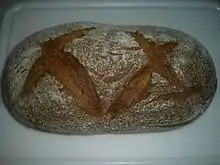klaips
Latvian
Etymology
Cognates include Lithuanian kliẽpas (“loaf”), Polish chleb (“bread”), Gothic 𐌷𐌻𐌰𐌹𐍆𐍃 (hlaifs, “bread”). Ultimately from Proto-Indo-European *kʷel- (“to turn, move”) nominalized to mean "disk, wheel, circle" (from the same root also Latvian kakls) because historically bread was a round, thin, hard flatbread. From the zero-grade Proto-Indo-European *kʷl-eip- : *kʷl-oip- > Proto-Baltic *kleip- : *klaip- whence the two Baltic terms.
Karulis notes that it has been a wandering Kulturwort as well, in Eastern Europe the word was spread during Gothic migrations and has thus been borrowed into Slavic with its Gothic meaning of "bread," while the Baltic languages retain the original meaning of "loaf."
An alternative view (Endzelīns, Trubačov) is that the word is a borrowing from Gothic. Another view (Būga, Otkupščikov) is that the word is an inherited Baltic word from Proto-Indo-European *(s)kel- (“to cut”), Karulis is critical of this proposal because the brittle flatbreads of the time were not sliced, pieces were simply broken off of them.[1]
Pronunciation
- IPA(key): [klàjps]
- IPA(key): [klâjps]
Usage notes
Some use klaips to refer to a loaf of dark rye bread and kukulis for a loaf of white bread but there is no set rule. Karulis notes that this division used to be more concrete earlier — in the 17th century klaips was specifically a large loaf of dark rye bread.
Declension
| singular (vienskaitlis) | plural (daudzskaitlis) | |
|---|---|---|
| nominative (nominatīvs) | klaips | klaipi |
| accusative (akuzatīvs) | klaipu | klaipus |
| genitive (ģenitīvs) | klaipa | klaipu |
| dative (datīvs) | klaipam | klaipiem |
| instrumental (instrumentālis) | klaipu | klaipiem |
| locative (lokatīvs) | klaipā | klaipos |
| vocative (vokatīvs) | klaips | klaipi |
Synonyms
- kukulis
- (dated, Soviet era) batons
References
- Karulis, Konstantīns (1992), “klaips”, in Latviešu Etimoloģijas Vārdnīca (in Latvian), Rīga: AVOTS, →ISBN
